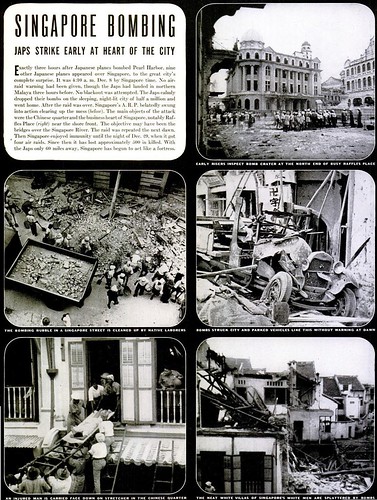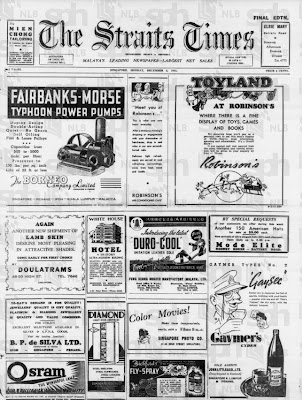Every 8 Dec when the world’s attention is focused on Pearl Harbor, we tend to forget the date is a historical one for Singapore too for on this day 69 years ago, the island experienced her first air raid. Three hours after WWII broke out in the Pacific with the Japanese landing at Kota Bahru and two hours after their surprise attack on Pearl Harbour, seventeen Mitsubishi G3M "Type 96" naval bombers appeared over Singapore after a harrowing 1000km journey from Saigon. The attack force consisted originally of sixty odd planes from the 22nd Air Flotilla but due to foul weather (thick clouds and rough winds, thanks ah), only 30% were to reach their destination; the rest called off the mission and returned to base. Bombs fell on Seletar and Tengah aerodromes; also the heart of the city at Raffles Place and Chinatown. The predawn raid just after 4am took the city by complete surprise.
The air raid was Singapore’s first tragedy in the war. Figures put the dead at 61 and wounded at over 700. You’d expect the news to make it to front page. After reading the Straits Times of 8 Dec 1941 however, I got a shock. The front page (containing the masthead) is nothing like our imagination. There were no headlines; instead I found the page choked full with advertisements!
The 8 Dec 1941 front page of Straits Times (retrieved via NLB). No headlines only advertisements. Note the "Toyland" ad by Robinson's on top right; ironically the department store was hit during the raid.
The report on the air raid was a small real estate on page 8, with no screaming title and accompanying illustration. An excerpt from this nondescript report of the event:
In Singapore
The first most people in Singapore knew of the existence of a state of war with Japan was when the air raid sirens sounded at about 4.15 am. Many people thought it was a test.
A.R.P. wardens were immediately on duty and though most of them had no advance warning. They acted with great initiative and enterprise.
The street lights of Singapore were not extinguished when the air raid sirens sounded.
Bombs were heard falling in several districts. It was officially stated subsequently that slight damage was done and there were a few casualties.
The air raid in Singapore took place in bright moonlight and a cloudy sky. The raiders, it is believed, flew over the clouds and were subjected to heavy anti-aircraft fire.
With the benefit of hindsight, we wonder whether the raid could be averted (probably not unless there was a supernatural storm over South China Sea) or at the least damages and casualties minimized. We are also puzzled as to why the air raid sirens did not sound earlier, resulting in the city taken by complete surprise.
Mitsubishi G3M of Mihoro Kokuta, the unit responsible for the air raid (source: wikipedia).
When I was younger, we were conditioned by our history syllabus to believe that the British military was crap. In fact one favorite essay question was to ask us the reasons for the British losing the war (i.e. Singapore). We memorized names like Buffalo and Vildebeest for British planes (aren't buffalos big and slow?) and facts like how Yamashita’s 250,000 troops defeated an enemy few times its size using nothing more than small tanks and bicycles. Tactics, weapons, experience, bravery, you name it the Japanese possessed them. Well, nearly everything except height - the Japanese were shorter than the Allies.
Despite their inadequacies, the British did not fare too badly in one area that could make a big difference in an air raid. I did a little research and found out before war erupted on 8 Dec, the British had four operational radar units in Malaya:
- MRU (Mobile Radio Unit) No. 250 erected at Tanah Merah Besar, Singapore
- TRU (Transportable Radio Unit) No. 243 erected at Mersing on the east coast of Malaya
- COL (Chain Overseas Low Flying) No. 511 sited at Bukit Chunang on southeast tip of Johore
- COL No. 512 sited at Tanjong Kupang on southwest tip of Johore
When one considers the radar and their operators performed admirably, what transpired on the night before the raid was therefore heartbreaking. To put events in perspective, the attack on Pearl Harbor commenced at 8am local time and ended with the retreat of the second wave two hours later. As Hawaii time zone is -10h and Malaya time zone +8h, 8am at 7 Dec in Hawaii was really 2am at 8 Dec in Malaya. We read the familiar account from Pearl Harbor: 7.02am at Opana Point in Hawaii, two privates detected on radar 50 or more aircraft approaching Oahu at a distance of 210km; report was promptly forwarded to the information centre but the sighting was mistaken to be their own B-17 by the lieutenant in charge.
Unlike the Pearl Harbor account now in our popular imagination, the Malayan account of the sighting - yes their radar detected the incoming just like in Hawaii - is not well known. At 3.20am the radar at Mersing detected the formation of aircraft over South China Sea, 120km north-east from the station, flying south. Ten minutes later the radar at Tanah Merah Besar picked up the signal. When due east of Singapore about 48km off the southeast tip of Johore, the formation turned west towards Singapore. Seletar was bombed at 4.15am followed by Tengah and the city. Apparently the formation was split into two equal groups, one group to draw anti-aircraft fire away from the other. I think none of the planes were downed.
I thought the similarity with Hawaii interesting: radar at Hawaii detected the incoming 210km away 50 minutes before the attack; the one at Tanah Merah Besar sighted the planes when they were 45 minutes and about 200km away (225km from Singapore to where the planes were first detected). I did some distance verification using Google Map. The figures "make sense" (see below).
View Singapore-Mersing Radar in a larger map
While we are informed by the Straits Times article that it was a moonlit and cloudy sky when they attacked and the planes were believed to fly over the clouds, I have read other accounts that say it was a clear moonlit sky. Again, the image of a cloudy sky turning clear just before the attack reminds us of Pearl Harbor:
They fly through clouds, wondering if Pearl Harbor will be visible. Then, as they near Oahu, the attack commander hears a Honolulu weather report: “clouds mostly over the mountains. Visibility good.” The clouds break. The fliers see “a long white line of coast”— Oahu’s Kakuku Point. [Source]
Further intrigued by the position of the moon in the sky, I went one step further and simulated, using Stellarium planetarium software, its exact position at 4.15am on 8 Dec 1941. The screen capture shows the view facing north, the moon at azimuth bearing 348 degs and elevation 74 degs.
As to why the air raid sirens did not sound, the general view is that the civilian authority especially the Governor did not have a war mentality; they were overconfident and underestimated the Japanese. The Governor, in particular, assured the people no Japanese bombs would be dropped on Singapore. With such attitude, no wonder the folks down the line were not "on the ball". The ARP Headquarters were not manned and shockingly they could not find the chap who could effect a blackout on the city during the raid.
If you are interested in the subject matter, do read this excellent article for a concise treatment on the Malayan radar units and the air raid.






















10 comments:
Very interesting write up! Im sure Kris would be interested too.
Thanks! :)
When u have the chance to read the de-classified US State Department files, you find that the Americans, Brits and Chinese were already "thinking" that the Japas will surely invade Malaya/Singapore not too far away.
As far back as 1940/41 when the Japs made demands on the Vichy Govt for unrestricted access through Vietnam to attack Generalissimo Chiang in Yunnan Province, Office of the Intelligence (OSS was fore-runner of CIA) spies already detected squadrons of Jap aircrafts moved to Saigon (from bases in Pearl River Delta)and 4 aircraft carriers anchored off Saigon for future attack on Malaya.
The Japs were using Hainan Island to practice dive bombing like what they did similar to Pearl Harbour on Dec 7, 1941.
During the 1930s, it was a practice at Staff College in India for officers to look at the defence of Malaya. Many came to the conclusion that the Japanese would land in the north and drive down the west coast of Malay. Lt Gen Percival came to the same conclusion when he produced an appreciation of the defence of Malaya. He was then (1936-1937) a Colonel, working as GSO 1, HQ Malaya Command.
Well I wouldn't dare say I'm a newspaper historian, but in early last decade newspapers (in general) were in part meant for businessmen and traders who have landed from faraway shores. Big companies would buy up first page ad space to gain presence. Hence there are many ads/shipping notices on the first page, quite the trend then (I observed from the Chinese papers in that era).
In this perspective, I offer a pretty naive view that perhaps they didn't want to startle traders. =)
That means ST was not sold like a tabloid, with screaming headlines to grab sales. Oh well, not many locals were could read English anyway.
I >3 tis blog abt WW2 Its so interesting...
Very interesting,thanks for sharing such a good information.
ดูบอลสด
ผลบอลเมื่อคืน
ผลบอลสด
NAGAQQ: AGEN BANDARQ BANDARQ ONLINE ADUQ ONLINE DOMINOQQ TERBAIK
Kami hadir dengan 12 Game Paling Hot & POPULER
(Poker, Bandar Poker , BandarQ, DominoQQ , AduQ ,Bandar66 , SAKONG , Capsa susun , Perang Baccarat , perang dadu , BDQQ, Adu Sakong )
Customer Service Kami Melayani 24 jam Nonstop !!!
No BOT !!! Player vs Player !!!
Hanya Di NAGAQQ
Contact us :
Link : nagaqqpro,net
WHATSAPP : +62 87833350051
I eenjoyed reading this
It is interesting to consider how historical events are portrayed differently across various media outlets.
Post a Comment